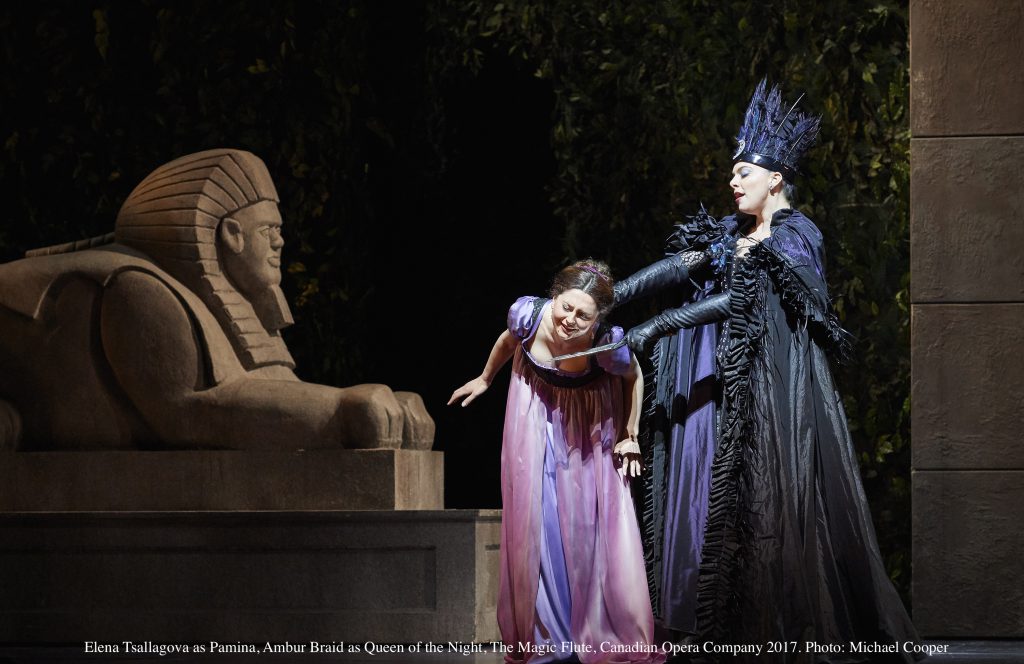The last act in Mozart’s life was already underway when Emanuel Schikaneder, über impresario, made an unexpected entrance, bringing with him a self-penned libretto to an odd, vaguely occult new singspiel. One glance at the text and Wolfgang Amadeus promptly leapt at the chance to set it.
The timing could not have been better. Or, as fate would have it, worse.
Mozart, sidelined by fickle Viennese society, perilously close to penniless, in precarious health, miraculously landed two upscale commissions in less than two months following Schikaneder’s visit. A court opera, La Clemenza di Tito, and a Requiem Mass sponsored by a recently widowed nobleman promised generous payouts. The former wunderkind from Salzburg chose to follow his heart. The two pressing top-drawer projects, one more lucrative than the other, were promptly shelved in favour of Schikaneder’s preposterously top heavy fairytale destined for the decidedly lowbrow, low-paying Theater auf der Wieden. It was as if Mozart had succumbed to some preternatural spell. The Magic Flute sprang from his pen virtually fully formed.
Enlightenment sensibilities, Freemasonry, burlesque comedy, love — all the themes and impulses that contained him and that he equally contained burst free from the piece reaffirming Mozart’s reputation as a preeminent crowd pleaser. Schikaneder, who pocketed most of the profits, extended the run.
Dead three months after its premiere on September 30, 1791 at the age of 35, The Magic Flute was to be Mozart’s unintended summing up, his final statement on reason, passion and the human condition.
Reprising its all-original production from 2011, the Canadian Opera Company casts a shaft of warm sunlight on a dreary Toronto winter with a bright, playful telling of Mozart’s ragged tale.
The libretto has bedevilled producers for centuries.
Act 1
An enchanted forest. A young prince, Tamino, races to save his life pursued by a dragon. Three Ladies, servants of the Queen of the Night, suddenly appear, slaying the monstrous creature. A bizarre figure enters bedecked in feathers. The Three Ladies know him well. Introducing Papageno, the bird catcher. Shown a portrait of the queen’s daughter, the fair Pamina, Tamino falls instantly in love. A clap of thunder. The Queen of the Night materializes from the darkness. The prince is recruited to rescue the beautiful princess from the clutches of her mother’s arch enemy, the all powerful sorcerer Sarastro, a merciless tyrant the queen insists. Gifted with a magic flute, Papageno with magic bells, Tamino and his zany accomplice set off on their quest.
Sarastro’s palace. Pamina is in grave danger. Sarastro’s fiendish henchman, Monostatos, is intent on ravaging her. Papageno accidentally stumbles upon the scene frightening the depraved villain with his alien bird-like appearance. Monostatos flees in terror. Recognizing Pamina from her picture, Papageno leads the shaken princess off in search of Tamino.
A sacred grove. Three young boys, spirits in the employ of the Queen of the Night, have led the dashing prince to a trio of mysterious temples. Barred from the first two, Tamino is confronted by a priest at the door to the third who informs him that Sarastro is neither the tyrant nor evil wizard the Queen of the Night described. The prince must acquire wisdom if he wishes to learn the true story, however. All he is to know for now is that Pamina is safe. Heartened by the news, Tamino summons Papageno by playing on his flute. Papageno answers on his bells, thwarting a counter attack by Monostatos and his slaves who are magically made to dance. Trumpets sound. Voices are heard singing Sarastro’s praises. Sarastro enters. Monostatos is sentenced to be flogged for his wicked designs on the princess. Tamino and Pamina are ushered into the temple where they are to gain passage to great blessings.
Act 2
The grove. Priests assembled. Sarastro announces that Prince and Princess are to be wed. Tamino shall be admitted to their hallowed fraternity. But first he must prove worthy.
Nine scenes follow. Tamino submits to a series of cryptic rites, trials by air, earth, fire and water all intended to test his devotion to goodness and virtue. Pamina undergoes ordeals of her own. Monostatos is dealt with for a third time. The Queen of the Night is defeated, her rage defied. Daughter Pamina will not agree to murder Sarastro to further her deceitful mother’s craving for dominion over the Forces of Light.
A new day dawns. The young couple, sanctified and liberated, beams with happiness. Papageno, too, is rewarded with his heart’s desire — a charming Papagena, a sweet and loving wife.
Present day critical conversation surrounding The Magic Flute has tended to be every bit as arcane as Schikaneder’s decidedly perplexing libretto. The task of deciphering it has become something of a cult. Interpretations range from the insightful to the improbable.
Shikaneder and Mozart were both Masons, possibly members of the same Lodge. Little wonder Masonic emblems, particularly the repeated evocation of the number three, a mystical value in the iconography of the notoriously secret brotherhood, recur in scene after scene. Mozart even went so far as to encode threes in his score, setting the bulk of his composition in E flat major, a key with three flats. What it all signifies is anyone’s guess.
Elsewhere, commentators have drawn sharp parallels to Jungian psychology. Principal characters like Sarastro, invariably associated with wisdom and intuition, and The Queen of the Night, raw energy personified, are undeniable archetypes, animus and anima. Whether the principles of early 20th century analysis can be applied to an overtly rationalist homily championing freedom of thought and action, however, is highly debatable.
All that can be deduced with any degree of reasonable certainty from the chaotic jumble of imagery and motifs that pervades The Magic Flute is that this is ultimately a chronicle that transcends simple meaning. Part love story, part social tract, Mozart’s last gift to opera is nothing less than humanity made mythic.
Broadway’s Diane Paulus (Pippin, Hair), originator of the current Magic Flute on view until late February at the Four Seasons Centre, faced considerable censure, largely undeserved, from local reviewers when the COC debuted its production. Framing the action as a play-within-a-play, a kind of homemade Baroque pantomime presented by members of a privileged 18th century clan for their own amusement, Paulus brought fantasy and make believe centre stage. The approach was refreshing, extracting context from confusion in a smart, inventive staging.
Revival director Ashlie Corcoran wisely elects to leave well enough alone. Not that every pre-existing pitfall has been patched. The notion of Pamina’s name day as a springboard for celebration is blithely offered as a gloss in Paulus’ program notes but nowhere else made evident. The evocation, illusory or otherwise, of a decidedly Christian custom seems doubly bewildering given the opera’s markedly pre-Christian Masonic roots.
The abrupt abandonment of the stage-on-stage conceit in favour of a fitful maze of self-animated hedges in Act II raises another lingering question. Reality or dreamscape? But these are essentially minor quibbles, slender notes to an otherwise appealing realization. The Magic Flute is essentially an expression of imagination run riot, a work in a state of constant flux. Director Corcoran does fine work maintaining ample momentum.
The level of musical refinement is no less profound. Acclaimed early music interpreter Bernard Labadie leads the splendid Canadian Opera Company Orchestra in a glowing, translucent performance of Mozart’s dazzling, multi-hued score. Orchestral colours are lavish, tempi exquisitely luxurious, often unexpectedly so.
Appearing as Tamino, tenor Andrew Haji invests the crusading Prince with abundant lyricism supported by rock solid technique. Singing with lovely, dreamy phrasing despite feeling unwell on opening night, Dies Bildnis ist bezaubernd schön (“This portrait is more enchanting”), Mozart’s irresistible celebration of a lover in love with love is brought charmingly to life as, invariably, are Haji’s other frequent virtuoso offerings during the course of the evening.
Making her COC debut as Pamina, Russian soprano Elena Tsallagova brings great strength of purpose and vitality to her role, fending off the most egregious aspects of the virtuous-heroine-as-victim syndrome, an annoying 18th century meme. Emotional, centred, vibrant, Tsallagova fashions an untypically charismatic Princess. Ach, ich fühl’s, es ist verschwunden (“Ah, I feel it, vanished”) is as bravely voiced as it is heartbreaking. A defining performance, surely.
Baritone Joshua Hopkins is a folksy, irrepressible Papageno bubbling with high spirits. Arguably gifted with all the best tunes by Mozart, the antic bird catcher, an Everyman in feathers, essentially owns each and every scene the instant he enters. Bubbly, exuberant, unabashedly physical, Hopkins holds us victim, delighted and spellbound. Ein Mädchen oder Weibchen wünscht Papageno sich! (“A little maid or wife, that’s what Papageno wants”), he chirps and when at last she appears it is the always captivating Jacqueline Woodley as his precious Papagena. Their iconic Pa-pa-Papagena! Pa-Pa-Papageno! duet is perfectly touching.
Soprano Ambur Braid is a gloriously malevolent Queen of the Night, all evil and darkness flashed with sequins and sparkling coloratura. Der Holle Rache (“The vengeance of hell”), the great, wickedly delicious revenge aria that rises from the opera’s psychic centre, is dispatched with gorgeous savagery, Braid tossing off entire handfuls of high Fs with unflappable self-assurance.
Croatian Bass Goran Jurić is a commanding Sarastro. Michael Colvin is a magnificently repellent Monastatos. Aviva Fortunata, Emily D’Angelo and Lauren Segal are the Three Ladies, delightful all. Owen McCausland and Neil Craighead form a strong, closely welded duo of Armed Men.
The Canadian Opera Company Chorus contributes rousing tonal mass and harmony as variable assemblies of country folk and priests.
Though not a first run presentation, this Magic Flute 2.0 nevertheless represents something of a milestone for the COC. Over 60% of all roles, principals, ensemblists, comprimari, are sung by Canadians, most graduates of the company’s extraordinary artist development program. The Ensemble Company has come of age.
This Magic Flute plays a poised, polished tune.


